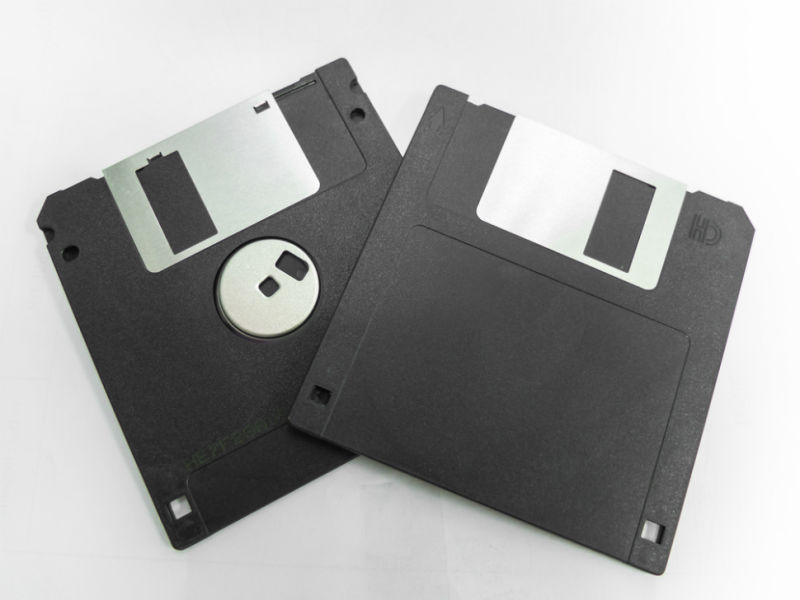

Some people may remember that the floppy disk was the ubiquitous data storage and exchange media, which allowed users to easily transfer their data from one computer to another.
Indeed, in the days before email attachments and USB sticks, there was simply no other way to move data around, unless of course the computer happened to be plugged into a network (but remember, most computing environments before the 1990s tended to be non-networked).
And as most PCs during this era tended to be desktop computers with very limited portability, the thin floppy disk gave users the freedom to use (or backup) their data wherever they happened to be located (providing the PC had a floppy disk drive of course).
Its widespread use led to creation of the term, ‘sneakernet.’
In the age of non-networking computers, the floppy disk was as the primary external writable storage device.
And to this day it remains a computing icon, having begun life back in the late 1960s, before it was eventually phased out in the late 2000s.
Typically the floppy was a piece of thin magnetic storage medium, usually contained with a bendable and rectangular plastic enclosure lined with fabric to remove dust particles (the biggest enemy of the floppy).
The floppy required a floppy disk drive (FDD), that was pretty much a standard option for millions of IBM-compatible PCs for decades.
It is important to note that the term ‘floppy disk’ applied to a range of different magnetic storage media.
Indeed, the granddaddy of the floppy disk was the original 8-inch media. Later this dinner plate sized media was shrunk down to 5¼-inch (which eventually boasted a staggering 1.2MB of storage capacity).
The final version was the much more rigid 3½-inch floppy (the so called ‘stiffy’) with a 1.44MB capacity.
As mentioned above, the floppy was not a perfect storage medium. It relied on a delicate floppy disk drive (FDD) to operate, where a mechanical arm would write the data onto the floppy’s magnetic platter. If the computer was jolted during this process, it could damage the platter.
And dust was also a huge problem, especially if the user left the floppy permanently inside the FDD. Users could even purchase a special floppy cleaning disk, to help combat this problem.
But the floppy was also susceptible to water damage and the human factor.
Urban legends tell of users stapling a floppy disk to paper reports. Another famous example was a user walking into a computer shop to complain loudly that their brand new floppy did work. The user then reportedly showed the floppy to the store owner by taking it out of his pocket. The floppy had been folded in half.
Perhaps because of these problems, manufacturers tried to come up with a host of alternative storage devices such as blank CD-ROMs and portable external hard disk drives.
But it was the ability to add attachments to emails, and the USB stick, that signalled the end for the floppy.
Apple had in 1998 launched the iMac, and it opted not to include a floppy disk drive in its machine. Dell likewise followed suit in 2003, as did Hewlett-Packard years later in 2009.
By the late 2000s, computers were rarely manufactured with floppy disk drives, and in 2010 Sony announced it would end domestic sales of the 3.5-inch floppy disk by the end of that year.
It actually ceased production of the floppy disk by March 2011.
But for at least 30 years the floppy disk (in all its various guises) was the primary writable storage device used around the world.
They were the main way of transferring data between computers, and were so instantly recognisable that a picture of a 3½-inch floppy disk even became the icon for saving data on many computers.
For a more modern take on storage tech, why not try out cloud in 2017 quiz?
Binance BNB token rises after WSJ report the Trump family is in talks to secure…
After failed Amazon deal, iRobot warns there is “substantial doubt about the Company's ability to…
Community Notes testing across Facebook, Instagram and Threads to begin next week in US, using…
Complete 180. FTC attorney now says federal agency can pursuit Amazon trial, after citing “severe…
Former board member and respected chip industry veteran Lip-Bu Tan appointed to lead troubled US…
MPs demand secret High Court hearing be held in public, after government had ordered a…
View Comments
I used to work on a help desk in the 80s. Where our callers were having floppy disk problems we used to ask them to send us a copy of the disk for checking. More than once we'd open the morning post to find carefully photocopied floppy disk images.